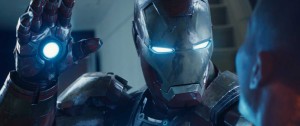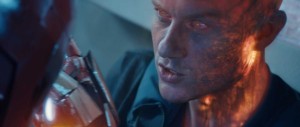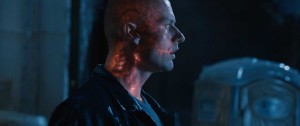
“Captain America was a period piece,” Townsend said. “It had a 1940s storybook feel. Iron Man 3 has a far grittier feel to it. Having said that, there are always things about the film we can refer back to.” This does not include just Captain America, but the whole trove of Marvel Universe assets. From the first two Tony Stark adventures to Joss Whedon‘s superhero extravaganza, all the uniform designs, palettes contained therein are available for reference.
But it wasn’t Townsend’s job to keep track of all the pieces in Marveldom assembled onscreen. “Kevin Faige oversees the projects creatively, with an eye for the overall feel,” he acknowledged. “We had a great history to look back at.”
“This looks different than Captain America,” he continued. Despite always looking back at what had been done before, this installment, with director Shane Black focusing more on Stark’s life outside the metal suit, Iron Man 3 has a lot more normal moments – him walking, getting a massage, just hanging out.
Of course, in the world of billionaire Stark, “hanging out” also means calling pieces of the Iron Man suit to you by remote control, snapping together like the fragments at the end of Iron Giant.
 Stark’s latest suit – he keeps tinkering and making new ones – is a little more slender in its form-fitting function than the previous 40 or so, but they all have to seem like they could have been invented by an actual person. “One reason Iron Man works is it’s grounded in reality,” Townsend said.
Stark’s latest suit – he keeps tinkering and making new ones – is a little more slender in its form-fitting function than the previous 40 or so, but they all have to seem like they could have been invented by an actual person. “One reason Iron Man works is it’s grounded in reality,” Townsend said.
And that real reality – for those working on the film – included racing to get footage of the remotely-assembled suit together in time for a Comic-Con preview last year. For help, Townsend turned to German VFX shop Trixter. “(They) helped define the look of the suit, as well as slamming through an amazing number of shots for the Con.”
“We were asked to come up with a new design language for all the unconnected parts and under-suit technology of the brand new Mark 42 Iron Man suit,” recalled Trixter’s VFX supervisor, Alessandro Cioffi. “We were also asked to design and test-animate the whole suit new connecting functionality.”
“As time was so much of a factor, we could only handle such complexity and meet the deadline thanks to the flexibility and the synergy in place between our art and CG departments,” explained Cioffi. “In fact, after the first phase where we defined the look, we could, at a later stage, gradually keep working on the design together – with Chris supervising the process overseas tweaking or changing entire parts – in an efficient way while the assets were full in production, and then address the changes in the CG department.”
“All in all, the two main issues we encountered were of a different nature – a more creative one, and a more technical one. On the creative, we were asked to come up with an animation language, which could maintain the mechanical integrity that Iron Man movies all had. On the technical side, the trickiest challenge, together with the animation, was definitely match-moving the suit, a rigid body, over Robert Downey Jr.‘s body who had to perform in a very unusual and unnatural fashion, simulating the impacts and acting his reactions to the wildly assembling suit.”
 Having made the Comic-Con deadline, and stirred up a buzz by using what becomes a defining scene early in the film, Townsend had to stay busy overseeing a lot of vendors. “There was a tremendous amount of work, and we didn’t have much time,” Townsend said. Although ILM oversaw effects for the previous Iron Man installments, here he presided over contributions from shops that included Digital Domain, Weta, Framestore and Scanline.
Having made the Comic-Con deadline, and stirred up a buzz by using what becomes a defining scene early in the film, Townsend had to stay busy overseeing a lot of vendors. “There was a tremendous amount of work, and we didn’t have much time,” Townsend said. Although ILM oversaw effects for the previous Iron Man installments, here he presided over contributions from shops that included Digital Domain, Weta, Framestore and Scanline.
Townsend tries not to share shots whenever possible. “We were somewhat successful with that,” he said. But with a looming release date, they ended up having to share some shots after all.
Method Studios was another of the vendors used, and they did some work on the Iron Patriot suit and other sequences. The film is nothing if not rich in various Iron Man outfits, which themselves become critical plot points throughout.
Blake Sweeney, Method’s CG supervisor, talked about how those pieces all fit together. “We got the Iron Patriot model from Digital Domain with textures for the external shell of the suit and some internal pieces for the suit to give us a starting point for the complex understructure.”
“Method’s team started by pouring over every scene in previous movies where Iron Man suits opened or closed and devised a plan for how the pieces should split for the opening. Our modeling team then sliced the external suit, capped the pieces on the inside, and then added all of the internal pieces that give Iron Patriot suit a look of extreme complexity.”
 Besides the suits themselves, the film also boasts the expected array of explosions, a significant flood and the side-effects of an engineered virus called Extremis, which results in biological explosions, superhuman strength and some interesting applications of fire.
Besides the suits themselves, the film also boasts the expected array of explosions, a significant flood and the side-effects of an engineered virus called Extremis, which results in biological explosions, superhuman strength and some interesting applications of fire.
Sweeney explained that for Extremis, Framestore provided a remarkably complete model for human physiology including arteries, tendons, muscles and bones. This internal structure was enhanced with animated FX and glows seen as refraction through the outer skin. Then that was provided to comp with a ton of control maps for the final product.
“Also, we were given a handful of reference shots for the Extremis look from Framestore, Weta, and Digital Domain, which cut down on our development time significantly since there was a target look previously established,” Sweeney said.
“Everyone is upping their game,” Townsend said of the contributions to what is already a resounding box office success. There were around 1,200-1,400 artists involved, he noted, based in six different countries, with 17 different companies working on the effects.
“Iron Man 3 was a two-year project, where everyone just put one foot in front of the other,” Townsend said. “I came away thinking it was crazy we pulled it off.”
Townsend will get a chance to pull off something crazy again very shortly. His next supervisorial job will be on a “small little film,” currently going by the working title Avengers 2.





